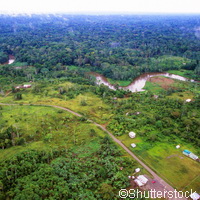Learning from the past to protect the future
Scientists in France, the United Kingdom and the United States have found that modern man can learn a lot about land management by taking a look at what happened in the past. The study, presented in the journal PNAS, put the spotlight on the Amazonian area, indicating that its earliest inhabitants managed their farmland sustainably. The data suggest that indigenous people who lived in the savannas around the Amazonian forest farmed without the use of fire. Led by the College of Humanities at the University of Exeter in the United Kingdom, researchers from the Centre National de la Recherche Scientifique (CNRS) and the University of Montpellier in France, the University of Edinburgh in the United Kingdom and the University of Utah in the United States said their findings could shed fresh light into the sustainable use and conservation of one of the planet's most important ecosystems. Researchers around the globe are studying ways to save these ecosystems that are being destroyed quite rapidly. With respect to the Amazonian savannas, the land is being targeted for industrial agriculture and cattle ranching. The researchers evaluated records of pollen, charcoal and other plant remains, such as phytoliths, spanning more than 2 000 years. They developed an accurate picture of land use in the Amazonian savannas in French Guiana, giving us a fresh perspective on the land before and after the 1492 appearance of Europeans. Based on the data, the early inhabitants of this specific area practised 'raised-field' farming. This type of activity focused on building small agricultural mounds with wooden tools, effectively providing improved drainage, soil aeration and moisture retention. This practice was particularly significant for the savannas, an area that experiences both drought and flooding. Increased fertility from the muck continually scraped from the flooded basin and deposited on the mounds also proved to be an advantage for the fields, according to the researchers. The farmers of this time restricted the use of fire, which in turn helped them conserve soil nutrients and organic matter. They were also able to preserve the structure of the soil. 'We used radiocarbon dating to establish the age of the raised beds,' said Dr Mitchell Power of the University of Utah, one of authors of the study. 'We came to the conclusion that corn pollen we found dated to 800 years ago, by dating charcoal deposits from above and below the sediment where the pollen was found.' This study helps put to rest the theory that indigenous people used fire as a way to clear the savannas and manage their land. The results point to a sharp increase in fires with the arrival of the first Europeans, the so-called 'Columbian Encounter'. Commenting on the results of the study, lead author Dr José Iriarte of the University of Exeter said: 'This ancient, time-tested, fire-free land use could pave the way for the modern implementation of raised-field agriculture in rural areas of Amazonia. Intensive raised-field agriculture can become an alternative to burning down tropical forest for slash-and-burn agriculture by reclaiming otherwise abandoned and new savannah ecosystems created by deforestation. It has the capability of helping curb carbon emissions and at the same time provide food security for the more vulnerable and poorest rural populations.' For his part, co-author Professor Doyle McKey of the University of Montpellier said: 'Amazonian savannas are among the most important ecosystems on Earth, supporting a rich variety of plants and animals. They are also essential to managing climate. Whereas savannas today are often associated with frequent fire and high carbon emissions, our results show that this was not always so. With global warming, it is more important than ever before that we find a sustainable way to manage savannas. The clues to how to achieve this could be in the 2 000 years of history that we have unlocked.'For more information, please visit:University of Exeter:http://www.exeter.ac.uk/PNAS:http://www.pnas.org/
Countries
France, United Kingdom, United States



